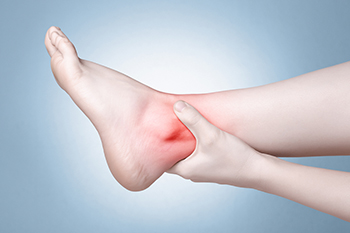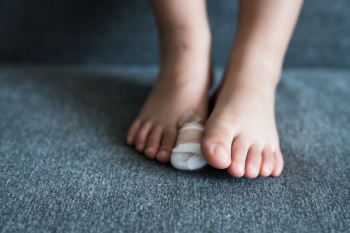
Os trigonum syndrome is a painful condition that occurs when an extra bone at the back of the ankle, called the os trigonum, becomes irritated. This small piece of bone is present in some people and usually does not cause problems. However, repetitive ankle movement, such as pointing the toes during ballet, soccer, or running, can trap this bone between the heel and ankle, leading to pain and swelling. Symptoms often include deep aching at the back of the ankle, tenderness when pressing on the area, and discomfort that worsens with activity. It may be mistaken for other ankle injuries, which is why an accurate diagnosis from a podiatrist is important. Treatment includes rest, anti-inflammatory medication, targeted exercise, or supportive footwear. In more severe cases, surgery to remove the os trigonum can relieve pain and restore ankle function. If you have pain or swelling at the back of your ankle, it is suggested that you schedule an appointment with a podiatrist for a diagnosis and proper treatment.
Ankle pain can be caused by a number of problems and may be potentially serious. If you have ankle pain, consult with Glenn Aufseeser, DPM from Lakewood Foot and Ankle Specialists. Our doctor will assess your condition and provide you with quality foot and ankle treatment.
Ankle pain is any condition that causes pain in the ankle. Due to the fact that the ankle consists of tendons, muscles, bones, and ligaments, ankle pain can come from a number of different conditions.
Causes
The most common causes of ankle pain include:
- Types of arthritis (rheumatoid, osteoarthritis, and gout)
- Ankle sprains
- Broken ankles
- Achilles tendonitis
- Achilles tendon rupture
- Stress fractures
- Bursitis
- Tarsal tunnel syndrome
- Plantar fasciitis
Symptoms
Symptoms of ankle injury vary based upon the condition. Pain may include general pain and discomfort, swelling, aching, redness, bruising, burning or stabbing sensations, and/or loss of sensation.
Diagnosis
Due to the wide variety of potential causes of ankle pain, podiatrists will utilize a number of different methods to properly diagnose ankle pain. This can include asking for personal and family medical histories and of any recent injuries. Further diagnosis may include sensation tests, a physical examination, and potentially x-rays or other imaging tests.
Treatment
Just as the range of causes varies widely, so do treatments. Some more common treatments are rest, ice packs, keeping pressure off the foot, orthotics and braces, medication for inflammation and pain, and surgery.
If you have any questions please feel free to contact our offices located in Lakewood and Manchester Township, NJ . We offer the newest diagnostic tools and technology to treat your foot and ankle needs.

When an ingrown toenail keeps coming back or causes significant pain, treatment often moves beyond simple soaks and shoe changes. Partial nail avulsion is a common procedure where a podiatrist removes the offending edge to relieve pressure and allow the skin to heal. In some cases, a small amount of the nail root is treated with a chemical or laser to prevent regrowth in that section. For nails distorted by trauma or fungal infection, reconstructive techniques can restore a smoother edge and reduce future irritation. Persistent inflammation may be addressed with targeted medication to calm tissue and prevent infection. These approaches aim to correct the problem at its source rather than just relieve symptoms. If ingrown toenail discomfort, swelling, or infection continues despite initial care, a podiatrist can recommend the most effective option for lasting relief.
Ingrown toenails may initially present themselves as a minor discomfort, but they may progress into an infection in the skin without proper treatment. For more information about ingrown toenails, contact Glenn Aufseeser, DPM of Lakewood Foot and Ankle Specialists. Our doctor can provide the care you need to keep you pain-free and on your feet.
Ingrown Toenails
Ingrown toenails are caused when the corner or side of a toenail grows into the soft flesh surrounding it. They often result in redness, swelling, pain, and in some cases, infection. This condition typically affects the big toe and may recur if it is not treated properly.
Causes
- Improper toenail trimming
- Genetics
- Improper shoe fitting
- Injury from pedicures or nail picking
- Abnormal gait
- Poor hygiene
You are more likely to develop an ingrown toenail if you are obese, have diabetes, arthritis, or have any fungal infection in your nails. Additionally, people who have foot or toe deformities are at a higher risk of developing an ingrown toenail.
Symptoms
Some symptoms of ingrown toenails are redness, swelling, and pain. In rare cases, there may be a yellowish drainage coming from the nail.
Treatment
Ignoring an ingrown toenail can have serious complications. Infections of the nail border can progress to a deeper soft-tissue infection, which can then turn into a bone infection. You should always speak with your podiatrist if you suspect you have an ingrown toenail, especially if you have diabetes or poor circulation.
If you have any questions, please feel free to contact our offices located in Lakewood and Manchester Township, NJ . We offer the newest diagnostic and treatment technologies for all your foot care needs.

When choosing high heels, the most important measurement is the heel-to-ball length, not the overall foot size. This ensures proper alignment, allowing the ball of the foot to rest where the shoe bends. A poor fit in this area can cause instability, discomfort, and long-term issues. To improve stability, select heels with a pitch that remains perpendicular to the ground and a base that supports balance. Proper fit and posture reduce strain on the feet and lower legs. A podiatrist can assess your foot structure and recommend strategies or custom inserts to improve comfort in high heels. If you have developed a foot or ankle injury from frequently wearing high heels, it is suggested that you consult a podiatrist who can treat various foot injuries, and guide you how to choose high heels that properly fit your foot.
Getting the right shoe size is an important part of proper foot health. Seek the assistance of Glenn Aufseeser, DPM from Lakewood Foot and Ankle Specialists. Our doctor will provide the care you need to keep you pain-free and on your feet.
Getting the Right Shoe Size
There are many people who wear shoes that are the incorrect size, negatively affecting their feet and posture. Selecting the right shoes is not a difficult process, so long as you keep several things in mind when it comes to choosing the right pair.
- When visiting the shoe store, use the tools available to measure your foot.
- Be sure there is ‘wiggle room’. There should be about an inch between your toes and the tip of your shoes.
- Do not always assume you are the same size, as manufacturers run differently.
- Purchase shoes later in the day, as your feet swell as the day progresses.
- If a shoe is not comfortable, it is not suitable. Most shoes can’t be ‘broken in’, and comfort should be the ultimate goal when it comes to choosing the right pair of shoes
As our feet hold our body weight and keep us moving, it is important to treat them right. Picking the right pair of shoes can provide your feet comfort and mobility without pain.
If you have any questions, please feel free to contact our offices located in Lakewood and Manchester Township, NJ . We offer the newest diagnostic and treatment technologies for all your foot care needs.

A broken toe may seem minor, but without proper care, it can lead to lasting pain or deformity. Most broken toes result from stubbing the toe or dropping something heavy on it. Symptoms often include swelling, bruising, and difficulty walking. Some people hear a pop at the time of injury. Not all breaks cause the toe to look crooked, so it is important not to ignore the pain. Rest, elevation, and gentle compression can help in the first hours after injury. Wearing stiff-soled shoes can protect the toe during healing. In some cases, buddy taping to a neighboring toe is recommended. More serious fractures may need splinting or surgery. If your toe remains swollen, painful, or difficult to move after an injury, it is suggested that you see a podiatrist to confirm the diagnosis and receive the right treatment.
A broken toe can be very painful and lead to complications if not properly fixed. If you have any concerns about your feet, contact Glenn Aufseeser, DPM from Lakewood Foot and Ankle Specialists. Our doctor will treat your foot and ankle needs.
What to Know About a Broken Toe
Although most people try to avoid foot trauma such as banging, stubbing, or dropping heavy objects on their feet, the unfortunate fact is that it is a common occurrence. Given the fact that toes are positioned in front of the feet, they typically sustain the brunt of such trauma. When trauma occurs to a toe, the result can be a painful break (fracture).
Symptoms of a Broken Toe
- Throbbing pain
- Swelling
- Bruising on the skin and toenail
- The inability to move the toe
- Toe appears crooked or disfigured
- Tingling or numbness in the toe
Generally, it is best to stay off of the injured toe with the affected foot elevated.
Severe toe fractures may be treated with a splint, cast, and in some cases, minor surgery. Due to its position and the pressure it endures with daily activity, future complications can occur if the big toe is not properly treated.
If you have any questions, please feel free to contact our offices located in Lakewood and Manchester Township, NJ . We offer the newest diagnostic and treatment technologies for all your foot care needs.
